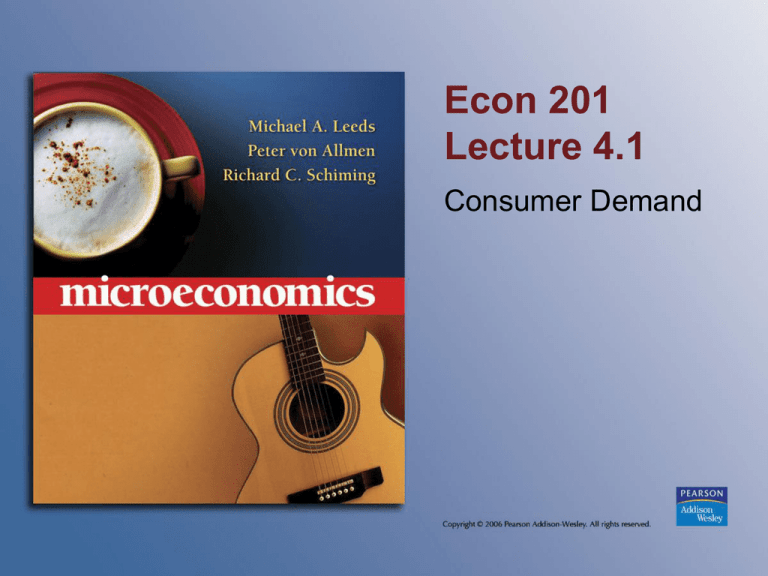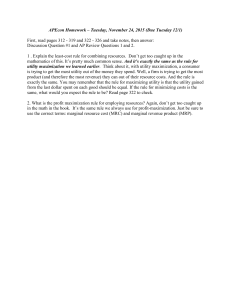
Econ 201
Lecture 4.1
Consumer Demand
Budget Line
• We represent the consumption
opportunities available to the consumer
with a budget line.
Shows the combinations of goods and
services consumers are able to consume,
given income and prices
Copyright © 2006 Pearson Addison-Wesley. All rights reserved.
7-2
Figure 7.1 The Budget Line
Copyright © 2006 Pearson Addison-Wesley. All rights reserved.
7-3
Budget Line Characteristics
• Each point on the budget line represents
consumption bundles of goods that
can be purchased at current prices with
a given amount of income.
• The budget line is a straight line with a
negative slope:
Slope of the budget line = Px Py
Represents the trade-offs between
the goods
Copyright © 2006 Pearson Addison-Wesley. All rights reserved.
7-4
Budget Line Characteristics (cont’d)
• The intercepts of the budget line
represent the maximum amounts of the
goods that the consumer can buy.
Found by dividing income by the price of
each good
• Consumption bundles outside the
budget line cannot be purchased with
the given income.
Copyright © 2006 Pearson Addison-Wesley. All rights reserved.
7-5
Figure 7.2(a) The Effect of Changes in
Income and Price on the Budget Line
Copyright © 2006 Pearson Addison-Wesley. All rights reserved.
7-6
Figure 7.2(b) The Effect of Changes in
Income and Price on the Budget Line
Copyright © 2006 Pearson Addison-Wesley. All rights reserved.
7-7
Assumptions about Consumer Behavior
• Consumers maximize their well-being, not
their income.
Doesn’t rule out altruism
Economists use the term utility to refer to the
benefits consumers receive from consuming
goods and services.
Copyright © 2006 Pearson Addison-Wesley. All rights reserved.
7-8
Assumptions about Consumer
Behavior (cont’d)
• Consumers are rational.
They behave in a consistent manner.
• Consumers have perfect foresight about
the satisfaction they will receive from a good
or service.
Copyright © 2006 Pearson Addison-Wesley. All rights reserved.
7-9
Marginal Utility
• Consumers make decisions based on
the additional benefit from consuming
one more unit of a good or service.
Marginal Utility (MU)—the change in
total utility that results from a one unit
change in consumption.
Copyright © 2006 Pearson Addison-Wesley. All rights reserved.
7-10
Maximizing Utility
• Consumers’ objective is to maximize
their utility, given the fact that their
income is limited.
• Consumers do this by comparing the
marginal utility of one good to the
amount of another good they must give
up to get it.
Copyright © 2006 Pearson Addison-Wesley. All rights reserved.
7-11
Marginal Utility per Dollar
• The first step in analyzing consumer
behavior is to calculate the marginal
utility a consumer receives from each
dollar spent on a good or service.
For example:
Marginal Utility of Pizza
Marginal Utility
per Dollar of Pizza
Price of Pizza
Copyright © 2006 Pearson Addison-Wesley. All rights reserved.
7-12
Utility Maximization
• Consumers maximize their utility by
allocating their income to the good that
yields the highest MU per dollar.
Copyright © 2006 Pearson Addison-Wesley. All rights reserved.
7-13
Utility Maximization (cont’d)
• For example, suppose a consumer
purchased two goods, CDs and Pizza:
If MUcd / Pcd > MUpizza / Ppizza then the
consumer should buy more CDs.
If MUpizza / Ppizza > MUcd / Pcd then the
consumer should buy more pizzas.
Copyright © 2006 Pearson Addison-Wesley. All rights reserved.
7-14
The Equimarginal Principle
• Thus, utility is maximized when the
marginal utility per dollar is equal
across all goods.
The consumer is in equilibrium.
Copyright © 2006 Pearson Addison-Wesley. All rights reserved.
7-15
Utility Maximization
and Individual Demand
• Downward-sloping individual demand curves
result from consumers maximizing their utility
subject to their budget constraint.
Copyright © 2006 Pearson Addison-Wesley. All rights reserved.
7-16
Income and Substitution Effects
• A change in the price of a good leads to
two effects:
The substitution effect—consumers
will purchase more a good that has
become relatively cheaper.
The income effect—a change in the
price of a good changes a consumer’s
purchasing power.
Copyright © 2006 Pearson Addison-Wesley. All rights reserved.
7-17
Income and Substitution Effects (cont’d)
• For normal goods, the income effect
reinforces the substitution effect.
• For inferior goods, the income effect
partially offsets the substitution effect.
Copyright © 2006 Pearson Addison-Wesley. All rights reserved.
7-18
Summary
• All consumers make decisions by
allocating their limited income over
the goods and services they would like
to consume.
• Consumers maximize utility, are
rational, and have perfect foresight.
Copyright © 2006 Pearson Addison-Wesley. All rights reserved.
7-19
Summary (cont’d)
• Consumers will allocate their income
such that marginal utility per dollar spent
is equal across goods.
• Other things remaining constant,
consumers will alter their purchases
of a good when the price of that
good changes.
Individual demand is the result of
utility maximization.
Copyright © 2006 Pearson Addison-Wesley. All rights reserved.
7-20







